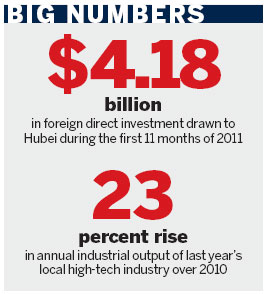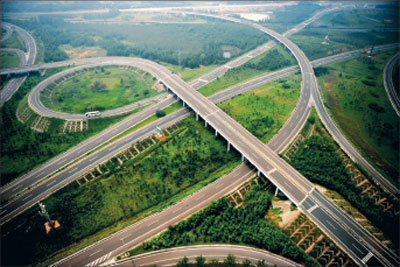Land of 1,000 lakes rich in resources
Updated: 2012-02-17 15:14
By Zhou Lihua (China Daily)
|
||||||||
|
Advanced highway network in the province. |

The Three Gorges Quantong Coated and Galvanized Plate Co Ltd, based in Hubei province, secured 35 billion yuan ($5.6 billion) worth of orders at the end of 2011. The company has grown into the largest domestic manufacturer of ultra-thin coated and galvanized plates over the past few years.
"It is Hubei that makes my career," said Liang Shichen, board chairman of the company. Liang isn't the only one who feels the charms of the Central China province.
Hubei attracted more than $4.18 billion in foreign direct investment during the first 11 months of last year, an increase of 12.6 percent year-on-year.
Nearly 100 of the Fortune 500 firms set up facilities here. Large State-owned enterprises have signed on to 78 major provincial projects at a combined investment total of 520 billion yuan.
Hubei is enjoying a fast growth rate with significant influence over the national economic landscape, said Chang Zhenming, board chairman of investment company CITIC Group.
With greater prestige and growing appeal to investors, the province is emerging as an investment hot spot, observers said.
Driven by investment projects, Hubei generated 1.96 trillion yuan in annual production value in 2011, increasing 13.8 percent over 2010 and ranking among the top 10 provincial economies.
Meanwhile, provincial foreign trade volume stood at $33.52 billion in 2011, rising 29.1 percent over 2010, which is 6.6 percent higher than the national average.
Resources
Behind the boom lay the rich resources of Hubei, dubbed as "the province of 1,000 lakes". Part of the Three Gorges Dam Project, topping the world in electricity generating capacity, is located here.
A widespread transportation network covering airways, waterways and land adds another appeal.
The provincial capital of Hubei has transformed into an inland high-speed railway hub. The Yangtze River and the Hanjiang River converge there.
Along with national agricultural bases - the Hanjiang River Plains and the North Hubei Hillocks - the province is a grain center. Its production of cotton, edible oils and freshwater products stands at the forefront of the nation.
Compared with its natural richness, Hubei remains abundant in human resources as well, since 122 universities and colleges along with about 1,500 research institutes have been based here.
A total of 57 experts of the Chinese Academy of Sciences and the Chinese Academy of Engineering work in Hubei, which ranks third among Chinese provinces.
It has imported 78 overseas experts and specialists since the central government initiated the Recruitment Program of Global Experts in 2008.
Hubei has sharpened its edge in R&D capacity in a range of high-tech sectors, including optoelectronics information, new materials, bioengineering and biomedicine, aerospace, computer-controlled technology, software and laser.
The high-tech sectors captured more than 230 billion yuan in annual industrial output last year, an increase of about 23 percent compared with 2010.

 Relief reaches isolated village
Relief reaches isolated village
 Rainfall poses new threats to quake-hit region
Rainfall poses new threats to quake-hit region
 Funerals begin for Boston bombing victims
Funerals begin for Boston bombing victims
 Quake takeaway from China's Air Force
Quake takeaway from China's Air Force
 Obama celebrates young inventors at science fair
Obama celebrates young inventors at science fair
 Earth Day marked around the world
Earth Day marked around the world
 Volunteer team helping students find sense of normalcy
Volunteer team helping students find sense of normalcy
 Ethnic groups quick to join rescue efforts
Ethnic groups quick to join rescue efforts
Most Viewed
Editor's Picks

|

|

|

|

|

|
Today's Top News
Health new priority for quake zone
Xi meets US top military officer
Japan's boats driven out of Diaoyu
China mulls online shopping legislation
Bird flu death toll rises to 22
Putin appoints new ambassador to China
Japanese ships blocked from Diaoyu Islands
Inspired by Guan, more Chinese pick up golf
US Weekly

|

|








